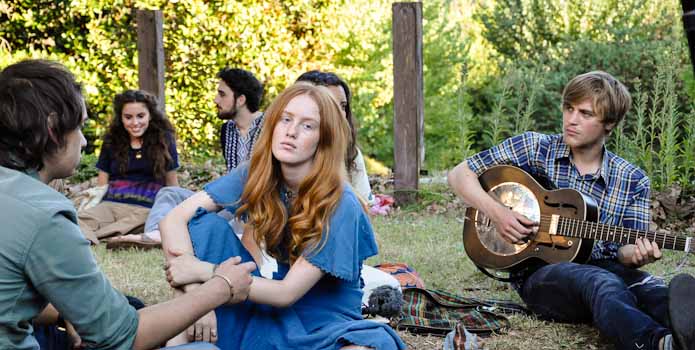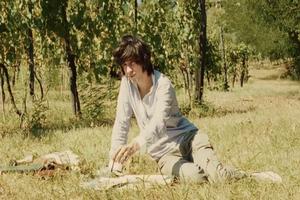In his latest film Something in the Air (Après mai), Assayas continues this exploration of revolutionary movements with an autobiographical story about a young man living in 1970s France. Perhaps because Assayas is more at peace with himself, the frustration and nihilism of Cold Water and Carlos has been replaced by a more optimistic and blissful tone in Something in the Air.
The French title of the film, Après mai, translates to “after May,” referring to the May 1968 student protest movement in France, a major event in which students joined with laborers to stage a strike which brought the economy to a standstill. The protagonist of Something in the Air is Gilles (Clément Métayer), a student in the early 1970s who joins a group of classmates in revolutionary activities to protest the corrupt activities of the French government. All of their actions are influenced by the May 1968 protest movement, but throughout the film, Gilles struggles between his commitment to his political beliefs, and his artistic endeavors as a painter, and eventually as a filmmaker.
Indeed, this is the central theme of Something in the Air—the conflict between political conviction and the more individualistic path of the artist. Gilles finds himself more drawn to the world of painting and the arts, while his friends drift steadily further into more dangerous political militancy.
Eventually, as in Jean Luc-Godard’s film La Chinoise, the political activities of Gilles’ friends lead them to contemplate an act of violence. Gilles, on the other hand, decides to devote his time to the arts. For Assayas, what began as youthful idealism for French students during the 1970s ultimately leads to disillusionment.
Gilles’ first girlfriend Laure (Carol Combes) becomes enmeshed in the political activites of the 1970s, culminating in a hallucinatory scene in which she imagines herself being engulfed in flames. Later in the film, as Gilles attends a festival for experimental films, he imagines seeing Laure on-screen in a beautiful, sun-drenched field. The message is clear—in the increasingly disjointed realm of political disillusionment, Laure’s fate is violent and hopeless, while in the realm of the arts, Laure finds herself in a world of beauty and optimism. For Assayas, art in its purest form is free from all political didacticism, and is universal and unchanging in its eternal search for beauty and the truth.
The very aesthetics of Something in the Air reflects this search for beauty in its truest sense. Assayas hired non-professional actors for the film because he wanted to avoid the artificiality and theatricality of more professionally trained actors. Instead, the performances in Something in the Air feel real and honest, resulting in a naturalism that is almost startling in its authenticity. In an interesting subplot, the filmmaking collective that Gilles' new girlfriend Christine (Lola Créton) becomes involved in proposes to do what Assayas himself did in Something in the Air—to film the laborers in their natural settings without hiring any professional actors.
Similarly, Something in the Air is filmed in a straightforward, almost documentary manner, as the camera becomes a non-intrusive observer of the events it is capturing. Many scenes are filmed from long and medium long shots, giving the actors a comfortable distance so that they can perform more naturally and without being aware of the presence of the camera. This results in performances which feel natural and non-imposed upon.
At one point, as Gilles attends a screening of political films, an audience member confronts the filmmakers about why they are not using a more radical, experimental style to tell their story. The filmmakers respond by saying they want to make films whose form does not conform to the alienating, sometimes incomprehensible style of what they call “bourgeois filmmaking.” Instead, they want to make films that mirror the real world in its truest form, just as Assayas himself is attempting to do in Something in the Air.
Ultimately, with Something in the Air, Assayas is trying to return cinema to a more naturalistic realm, one which is free from political dogmatism and the constraints of traditional narrative filmmaking.
The character of Gilles does not essentially change from the beginning of the film to the end, as is required for more traditionally oriented Hollywood style narrative films, in which the protagonist has to have some sort of character arc or encounter obstacles to overcome. This is a very individualistic and even imperialistic form of filmmaking, one in which the central theme is that of the individual himself or herself, free from any help from the wider society, ultimately triumphing over and controlling his or her environment.
It is interesting to note that many Western critics have complained that they couldn’t identify or empathize with any of the characters in Something in the Air because they weren’t portrayed as being individuals, or as being indistinguishable from the other characters. This was done intentionally by Assayas to confront the more Westernized, individualistic form of cinema, and to show that we should view ourselves as being more attached to the collective environment, than as being individuals isolated from each other.
This is also a more subtle way for Assayas to come to terms with the utopian ideas of the 1970s, in which the youth envisioned a future society where everyone was connected to each other in a universal collective. This is an idea that still exists today, as revealed in the recent Occupy movement, and one which will continue to exist as new generations of youth struggle to build a more optimistic future.




No comments:
Post a Comment